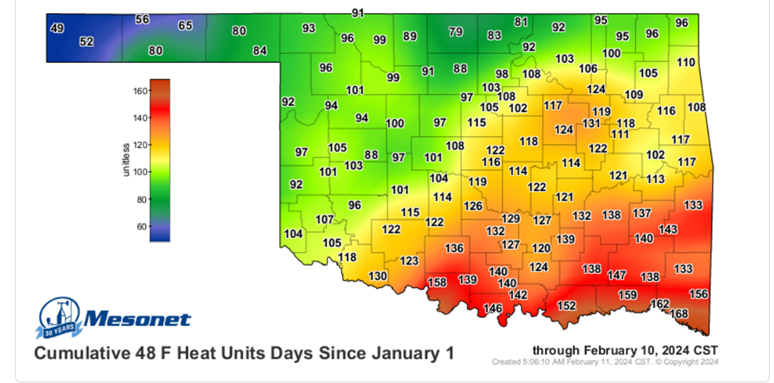Start of Alfalfa Weevil Season is Approaching
As temperatures start to increase, it’s time for alfalfa producers to start thinking about alfalfa weevil (AW) season. Degree day numbers in many areas of the southern part of the state are at 150 (Fig. 1). As mentioned in previous reports, 150 is the magic number we look to for beginning to scout fields for increasing AW larval activity. As temperatures and degree days (DD) continue to build, movement into central and northern parts of the state can occur quickly.
While we may be getting close to our time to start scouting, many factors can influence how quickly AW larvae develop and when threshold is achieved. Last year, a mild winter caused DD numbers to build early requiring many first insecticide applications to be made by late February. In a typical year, the first applications are not made until late March. Severe weather events, with varying cold and warm periods can affect development. The use of the Alfalfa Weevil Model found on the Oklahoma Mesonet, can be a useful tool for identifying when start scouting in your area.
Figure 1. Degree Day accumulation through February 10. Alfalfa Weevil Model, Oklahoma Mesonet.
With the recent cooler weather AW activity will decrease, however, when conditions moderate and start to warm again activity can increase quickly. Stay vigilant with field monitoring. Remember 150-degree days is just an estimate of when to start scouting (Table 1.). Many variables can influence when actual threshold timing occurs. The 2-week forecast for central Oklahoma is near normal with lows averaging 34 oF and daily highs averaging 57 oF. Given these ranges, minimal degree days would accumulate, however, slight adjustments upward would increase insect activity, especially in southern parts of the state.
Table 1. Estimated Timeline for Alfalfa Weevil Degree Day Development and Potential Damage.
| Degree Days or Head Units | Stage | Importance |
|---|---|---|
| 150 | Egg development and hatch | In stems - start scouting |
| 150-290 | 1st and 2nd Instars | Leaf pinholing |
| 290-540 | 2nd and 3rd Instars | Defoliation |
| 540-750 | 3rd and 4th Instars | Defoliation |
| 750+ | Pupae to Adult | Adults-some feeding. Oversummering. |
* Weather can delay or enhance development.
With the evolution of AW resistance to pyrethroids (particularly lambda-cyhalothrin), scouting and monitoring of insect development, use of IPM strategies, and identification of threshold timing are all critical in helping to delay insect resistance. However, properly timed chemical applications are usually needed for ultimate control. Levels of resistance vary throughout the state. While some pyrethroid products may still have some efficacy, others may not. Keeping good records is essential. Being able to identify if insecticide efficacy starts to decline, products being used, and their mode of action (MoA) can help to identify when a new rotation for control is needed. Unfortunately, the continued use of pyrethroids, while economical, has increased our chances for cross-resistance to other pyrethroids in the group 3 (MoA) class. If the current trend continues and more pyrethroids develop cross-resistance, MoA rotations will be further limited, and existing products will be severely stressed.
Some good news for alfalfa growers this season. It has been announced that Lorsban (active ingredient chlorpyrifos) has been reinstated for use based on previously labeled commodities, including alfalfa. This addition to the insecticide rotation could be a game changer in the upcoming season. However, we should remain cautiously optimistic on chlorpyrifos’s future. A revised EPA review is ongoing and limited supplies may hinder availability moving forward.
A list of current labeled products for alfalfa weevil in Oklahoma can be found in CR 7150, Alfalfa Forage Insect Control.

